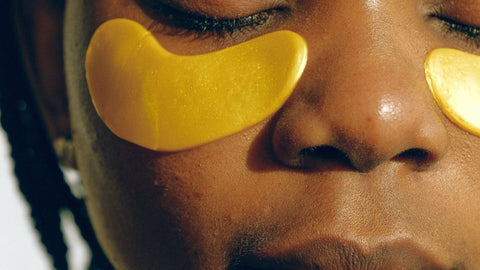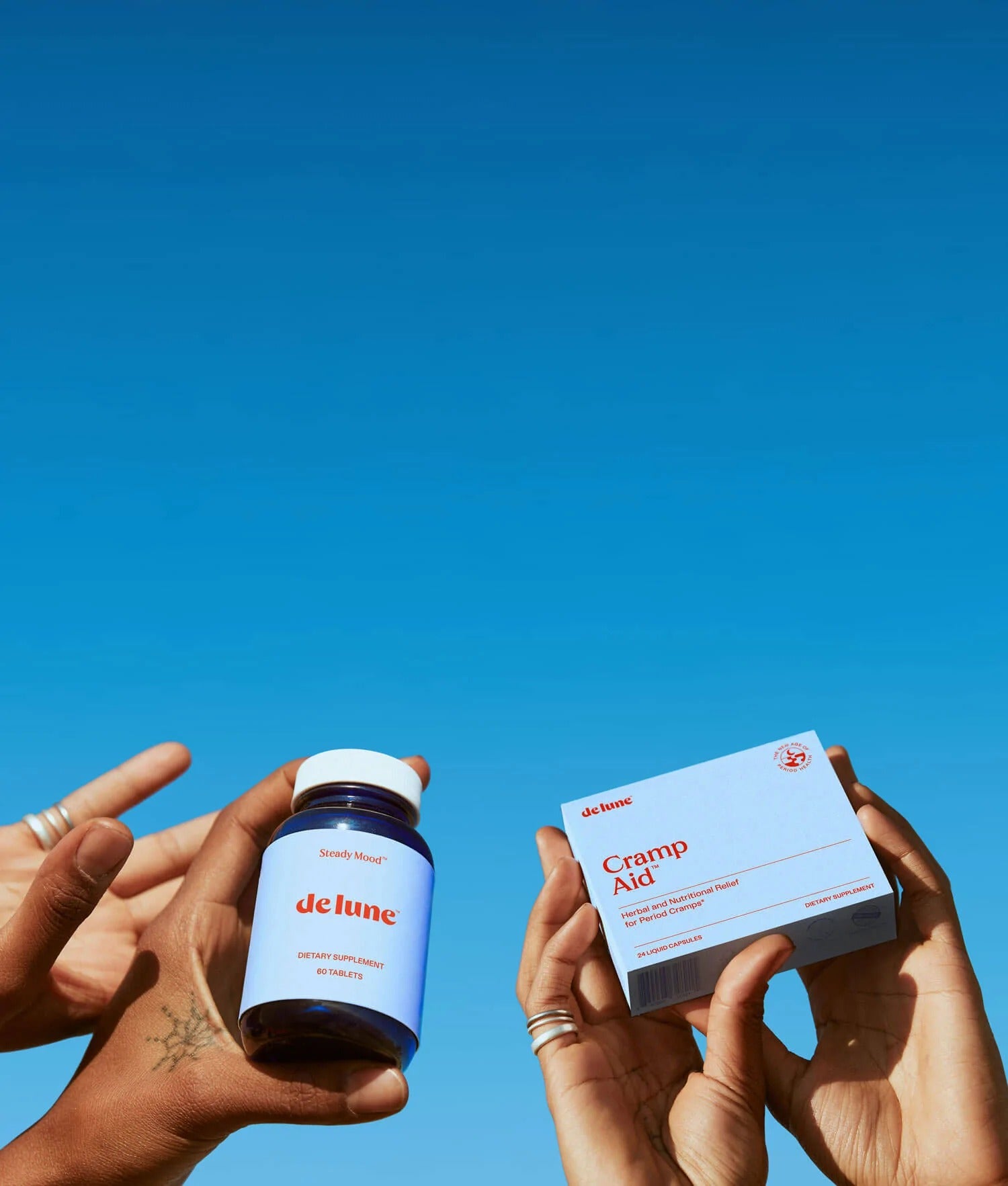What helps with cramps from period pain isn’t always straightforward. Because all menstrual matters tend to be kept very hush-hush, the most evidence-based options for how to get rid of cramps on period days aren’t always common knowledge. As a result, people with really bad cramps don’t always get the support they need.
We’re here to change that. This article explains how to get rid of cramps fast, period. It covers:
- What helps with cramping on your period in the moment, and the pros and cons of each method
- How long each option takes to help with cramps, and what level of cramp relief you can expect
- Why the fastest, most effective period cramp remedies happen to be natural medicine
- How to get rid of cramps on your period for good, with key tips for prevention
What helps with cramping on your period?
The secret for how to help with cramps on your period lies in targeting what causes menstrual pain in the first place. There are three big events happening in the uterus that cause cramping on your period:
- Inflammation
- Muscle contraction
- Lack of oxygen
All cramp remedies work to reduce period pain by targeting at least one of these three factors:
- By reducing inflammatory markers called prostaglandins that build up in the uterus before your period
- By relaxing uterine muscles, preventing them from contracting too tightly
- By improving oxygen flow to the uterus, the lack of which results in painful cramping
How to get rid of cramps fast
One thing on everyone’s mind when reaching for something to help with cramps: when are they going away.
“I think it’s a fair question,” De Lune founder & CEO Mimi Millard said in a recent podcast interview. “If I was looking for a new solution, that’s one of the first things I’d want to know—how long does it take to work?”
Great news: you can effectively get rid of period cramps fast—by some reports, within minutes of using an intervention. That said, not all interventions are created equal in terms of speed, effectiveness, or safety, nor will everybody react to all interventions in the same way.
Here are the top period cramp remedies with the best scientific evidence that they work for most people—and work quickly.
Clinical research shows certain dietary supplements—especially ginger extract, zinc, and hefty doses of vitamin B1—have been shown to be particularly effective for relieving period cramps fast. While you could get them from eating whole ginger root or foods containing zinc or vitamin B1, the science suggests the amounts of each substance needed to effectively reduce menstrual cramping are much higher than what the diet could reasonably provide, therefore supplements are necessary.
Each of these natural remedies work in different ways to help with cramping quickly. Clinical research shows ginger blocks the formation of pro-inflammatory prostaglandins [1, 2], zinc’s antioxidant activity improves oxygen flow to the uterus [3, 4], and vitamin B1 helps keep uterine muscles working their best. [5]
We combined ginger, zinc, and vitamin B1—in amounts shown to work for cramp relief in clinical trials—with other helpful supplements for menstrual pain in Cramp Aid: our fast-acting, non-drug solution to painful period cramps.
Time to relief:
In a survey of over 140 real Cramp Aid users, 93% reported finding cramp relief. For 78% of users, relief came within 60 minutes of taking just one 2-capsule serving of Cramp Aid.
Pros:
Natural remedies like supplements can provide non-drug cramp relief that’s safe, effective, and fast. Since nutritional and herbal supplements tend to act upon multiple organ systems at once, using them may also benefit other areas of your health as well.
Cons:
Although risks of side effects are generally lower with dietary supplements than with pharmaceuticals, side effects are possible, especially if:
- You take more than the recommended daily dose of a supplement
You combine different supplement products with common ingredients or effects
You’re taking a medication that interacts with a supplement’s ingredient(s)
You’re under 12
Always tell your doctor about all the supplements you take.

Non-Steroidal Anti-Inflammatory Drugs, or ‘NSAIDs’, are often recommended for cramp relief because they reduce the concentration of inflammatory prostaglandins in the uterus. Examples of NSAIDs include products such as ibuprofen, aspirin, and naproxen, and brands such as Midol, Advil, Motrin, and Aleve.
Time to relief:
NSAIDs begin working relatively quickly—by most reports, at a similar rate as Cramp Aid, between 30-60 minutes. But they don’t work for everyone. Whereas 93% of Cramp Aid reported it relieved their cramps, research shows NSAIDs are only effective against period pain for 82% of women. [6]
Pros:
Over-the-counter painkillers are popular for cramp relief because they’re cheap, widely available, and work for lots of people. While these factors are important, painkillers also come with safety risks that make them a far-from-perfect solution to period cramps…
Cons:
The Food and Drug Administration (FDA) warns against using painkillers for long periods of time due to potentially serious side effects, such as heart attack, stroke, and other safety risks. [7] While you may only need to take these drugs for a couple days each month, risks add up when you use them regularly for the ~35 years you have a menstrual cycle.
Heat therapy from an electric heating pad or disposable stick-on heating patches may help reduce period cramps by relaxing uterine muscles, and by promoting a healthy flow of oxygen to the area. [8]
Time to relief:
While the research isn’t clear about the exact time it takes for heat therapy to help with cramps, heat may work a bit faster than medication or supplements, which need time to be digested and absorbed. But heat isn’t likely to eliminate cramps instantly either. The uterus sits deep within the pelvic cavity, so heat must penetrate many layers of tissue before it reaches cramping uterine muscles.
Pros:
Heating pads and patches can be a non-drug way to help reduce menstrual pain that’s largely free of side effects. You can minimize risk of burns by avoiding applying high heat settings directly on the skin for long periods of time.
Cons:
Unlike electric heating pads or T.E.N.S. units, stick-on heating patches don’t require any wires or batteries. They are single-use, however. Depending on the brand, disposable patches offer anywhere between 6-12 hours of heat, after which they need to be replaced.
‘T.E.N.S.’ stands for Transcutaneous Electrical Nerve Stimulation. These machines are worn on the outside of the abdomen—similar to a heating patch. But instead of heating up, electrode pads that stick to the skin with tape send electrical currents toward the uterus, which are thought to dilate the blood vessels in uterine muscles, allowing more oxygen to reach them. [9]
Time to relief:
Most clinical research on TENS devices report pain reduction after using the device for about 30 minutes. [10]
Pros:
TENS units offer drug-free cramp relief, and are virtually free of side effects. Some brands may also be covered by most health insurance plans.
Cons:
Cost is the major drawback of TENS, with devices designed specifically for menstrual cramps running up to $139 per unit. While the machine itself is reusable, the adhesives that attach it to your body are not. The device also isn’t totally flat, and may not fit comfortably under all types of clothing.
How to get rid of cramps on your period for good
The best way to help with cramps on your period is to prevent them from happening in the first place.
Yes, it’s possible! The process that causes menstrual cramping—inflammation, muscle contraction, and lack of oxygen—is driven by hormonal fluctuations happening in the background of your menstrual cycle all month long.
Specifically, the hormone estrogen rises and falls during the first half of your cycle, in the weeks leading up to ovulation. In the second half, progesterone rises and falls, and estrogen gets a smaller, secondary bump.

How do hormones help with period cramps?
Estrogen and progesterone affect your period in different ways. Estrogen works to thicken the uterine lining, whereas progesterone prevents it from becoming too thick. The thicker the lining, the more inflammatory prostaglandins are produced, and the tighter uterine muscles have to contract to shed it, leading to worse cramping.
This means the baseline cramp severity you feel at the beginning of your period may be related to your body’s ratio of estrogen to progesterone in the ~14 days leading up to menstruation. Generally, the more progesterone you’re able to make after ovulation, the lighter and less crampy your periods will be, and the fewer PMS symptoms like anxiety, bloating, and fatigue come with them.
But there’s one catch: while it’s possible to get rid of cramps quickly once they start, preventing them altogether is a longer-term project. Experts recommend allowing ~90 days (roughly 3 menstrual cycles) for progesterone levels to optimize, as this is the typical lifespan of progesterone-producing cells and tissues. [11]
However, getting to the root of the issue can be well worth the effort, especially if you struggle with more severe cramps. The less intense your cramps are going into each cycle, the more effective remedies for quick, in-the-moment relief will be.
How to get rid of cramps and PMS on your period
It’s possible to help with cramping and other symptoms by supporting your cycle with healthy habits, all month long—conveniently, the same habits that make us healthier humans overall. Sticking to a sleep schedule or choosing foods for hormone support, for example, can noticeably reduce period pain. But these aren’t your only options. Behavior change is hard work, and we’re here to lighten the load.
We designed Steady Mood—our daily support for multi-symptom PMS relief—to address common factors that hinder progesterone production and worsen cramps and PMS: low levels of certain nutrients, inflammation, and stress. Two tablets a day nourish your entire hormonal cycle with the research-backed, anti-inflammatory vitamins and minerals it needs to thrive, while adaptogenic herbs soothe stress and fatigue.
Get Cramp Aid for fast cramp relief and Steady Mood for whole-cycle PMS happiness in our Period Rescue Kit, and enjoy a bundled discount for giving your cycle the care it deserves.
References
1. Ozgoli, G., Goli, M., & Moattar, F. (2009). Comparison of effects of ginger, mefenamic acid, and ibuprofen on pain in women with primary dysmenorrhea. The journal of alternative and complementary medicine, 15(2), 129-132.
2. Shirvani, M. A., Motahari-Tabari, N., & Alipour, A. (2015). The effect of mefenamic acid and ginger on pain relief in primary dysmenorrhea: a randomized clinical trial. Archives of gynecology and obstetrics, 291(6), 1277-1281.
3. Widatiningsih, S., & Handayani, E. (2017). Influence of Zinc Tablets Administration to Primary Dysmenorrhea Pain Level. ARC Journal of Nursing and Healthcare, 3(3), 35-38.
4. Sangestani, G., Khatiban, M., Marci, R., & Piva, I. (2015). The positive effects of zinc supplements on the improvement of primary dysmenorrhea and premenstrual symptoms: a double-blind, randomized, controlled trial. Journal of Midwifery and Reproductive Health, 3(3), 378-384.
5. Gokhale, L. B. (1996). Curative treatment of primary (spasmodic) dysmenorrhoea. Indian Journal of Medical Research, 103, 227-231.
6. Oladosu, F. A., Tu, F. F., & Hellman, K. M. (2018). Nonsteroidal antiinflammatory drug resistance in dysmenorrhea: epidemiology, causes, and treatment. American journal of obstetrics and gynecology, 218(4), 390-400.
7. https://www.fda.gov/drugs/drug-safety-and-availability/fda-drug-safety-communication-fda-strengthens-warning-non-aspirin-nonsteroidal-anti-inflammatory
8. Jo, J., & Lee, S. H. (2018). Heat therapy for primary dysmenorrhea: A systematic review and meta-analysis of its effects on pain relief and quality of life. Scientific reports, 8(1), 1-8.
9. Igwea, S. E., Tabansi-Ochuogu, C. S., & Abaraogu, U. O. (2016). TENS and heat therapy for pain relief and quality of life improvement in individuals with primary dysmenorrhea: A systematic review. Complementary therapies in clinical practice, 24, 86-91.
10. Proctor, M., Farquhar, C., Stones, W., He, L., Zhu, X., & Brown, J. (2002). Transcutaneous electrical nerve stimulation for primary dysmenorrhoea. Cochrane Database of Systematic Reviews, (1).
11. https://www.ncbi.nlm.nih.gov/books/NBK278951/figure/morpho-physio-ovary_f_morpho-physio-ovary_figure1/
This information is for educational purposes only. It is not a substitute for professional medical advice, and is not intended to diagnose, treat, cure, or prevent any condition.








